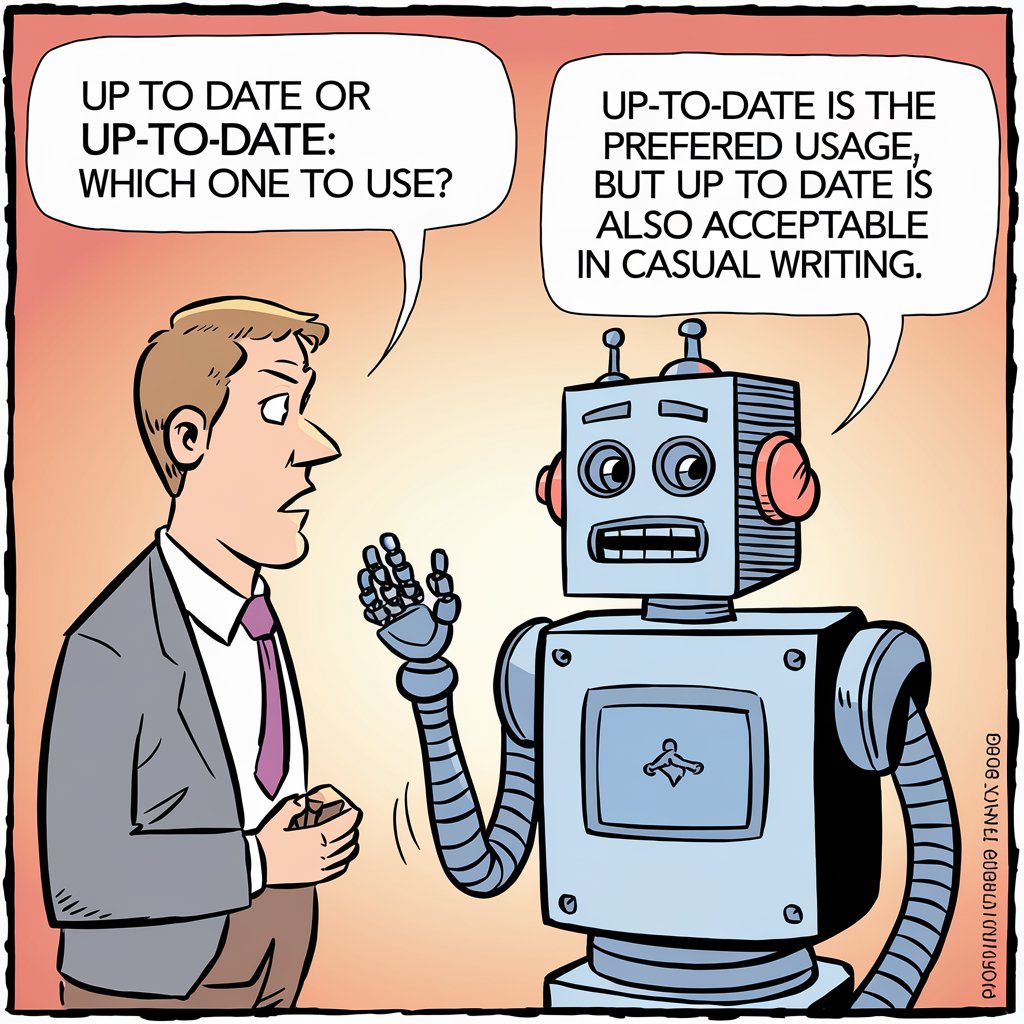Introduction
Have you ever wondered whether to write “up to date” vs “up-to-date”? You’re not alone. These two forms look similar but follow different grammar rules. Understanding when to use a hyphen ensures clarity and improves readability.
This guide will explain the difference beween up to date or up-to-date. This article will provide examples of these words. And help you master their correct usage. By the end, you’ll confidently apply the right form in any context.
Meaning & Usage
Up to Date (Prepositional Phrase)
- Refers to something current or modern.
- Typically follows a verb.
✅ Example: His software is up to date with the latest updates.
Up-to-Date (Adjective)
- Describes something as modern or advanced.
- Always used before a noun.
✅ Example: She bought an up-to-date laptop with cutting-edge features.
Read More About This Article: Full Time or Full-Time: The Right Way
Quick Comparison Table
| Term | Part of Speech | Meaning | Example |
|---|---|---|---|
| Up to date | Prepositional phrase | Current, recent | His medical records are up to date. |
| Up-to-date | Adjective | Latest, modern | She gave an up-to-date presentation on AI. |
Grammar Rules: When to Use Each Form
Using “Up to Date” Correctly
Use “up to date” as a prepositional phrase after a verb.
✅ Correct: Ensure your resume is up to date before applying.
❌ Incorrect: Ensure your resume is up-to-date before applying.
Using “Up-to-Date” Correctly
Use “up-to-date” as an adjective before a noun.
✅ Correct: This is an up-to-date grammar guide.
❌ Incorrect: This is an up to date grammar guide.
Common Mistakes & How to Avoid Them
Incorrect Hyphenation
❌ His vaccination record is up-to-date. (Should be: up to date)
❌ She read an up to date report on climate change. (Should be: up-to-date)
Overusing Hyphens
Some writers mistakenly add hyphens where they aren’t needed.
Ignoring Hyphenation in Adjectives
If “up-to-date” comes before a noun, it requires a hyphen.
Proper Usage in Different Contexts
Formal Writing
Academic papers and business documents should follow grammar rules carefully.
✅ Example: The research study must be up to date with the latest data.
Casual Writing & Speech
In informal settings, proper usage still improves clarity.
✅ Example: I love how this app stays up to date with trends.
SEO & Content Writing
For online content, “up-to-date” ranks better when describing products or guides.
✅ Example: Check out our up-to-date list of the best smartphones.
Examples in Different Fields
| Field | Correct Usage | Example |
|---|---|---|
| Business | Up to date | Ensure your financial records are up to date. |
| Technology | Up-to-date | We use up-to-date cybersecurity software. |
| Education | Up to date | His teaching methods remain up to date. |
| Healthcare | Up-to-date | This is an up-to-date medical guide. |
Synonyms & Alternatives
If you’re unsure which to use, try these alternatives:
- Up to date → current, recent, revised, modernized
- Up-to-date → latest, cutting-edge, contemporary, updated
| Phrase | Alternative | Example |
|---|---|---|
| Up to date vs Up-to-date | Current | Keep your passwords current. |
| Up-to-date vs Up to date | Latest | She owns the latest smartphone. |
Hyphenation Rules in English Grammar
When to Use Hyphens in Compound Adjectives
- Before a noun: Always hyphenate. (An up-to-date report)
- After a verb: No hyphen. (His report is up to date.)
When Hyphens Are Not Needed
- If the phrase is widely understood and doesn’t need clarification.
✅ Example: This method is tried and true.
Real-World Usage Examples
Books & Academic Writing
Published works maintain strict grammar rules.
✅ Example from The New York Times: “All statistics are kept up to date for accuracy.”
News Headlines
Journalists use “up-to-date” when modifying a noun.
✅ “Stay informed with our up-to-date election coverage.”
Marketing & Branding
Businesses use “up-to-date” to highlight modern products.
✅ “Our software offers up-to-date security solutions.”
Final Takeaway: Which One to Use?
To avoid mistakes, remember:
- Before a noun? → Use up-to-date.
- After a verb? → Use up to date.
Mnemonic Trick:
👉 “Adjective needs a hyphen, phrase does not.”
Proofreading Tip:
Substituting “up to date” or “up-to-date” with “current” or “latest” helps confirm the correct form.
✅ “Your training is current.” (✔ up to date)
✅ “This is the latest report.” (✔ up-to-date)
Conclusion
Mastering hyphenation rules makes your writing clearer and more professional. Key takeaways:
The word “Up to date” follows a verb and remains unhyphenated.
Hyphenated word of “Up-to-date” describes a noun and requires a hyphen.
Always proofread to ensure proper usage.
